SCA Garb
Recent Major Works
These outfits were more extensive work and were made for a specific reason. Their majesties wanted Japanese garb for court, and we make the outfits to show first at academy, then at SCA 50 year, and then again at Pennsic for court at Yama Kaminari camp. Note that the outfits are more warrior class, than formal imperial court style. Ishiyama's Bunkan Sokutai is formal court wear and appropriate for his elevation to the Order of the Laurel. His white under garments, the sashinuki pants, the footwear, kanmuri, and accessories were items that he had already or constructed/obtained for the occasion.
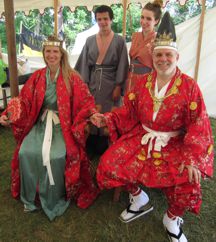 |
|
Royalty Garb:I made her majesty's outfit. The red, white, and yellow are kingdom colors. The sage green was her pick. The red hakama and the white obi are there to represent her status as a knight. |
I made the uchikake that Solveig wore for her elevation to the Order of the Laurel. |
|
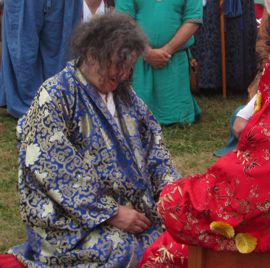 |
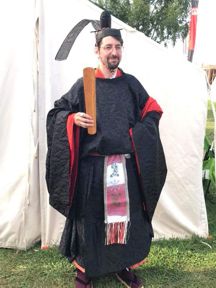 |
|
Garb for my honeybunny, Ishiyama, for his elevation to the Order of the Laurel. The outfit is called bunkan sokutai (hoeki no sokutai) sugata. |
The outer garment is known as a hoeki no ho. |
|
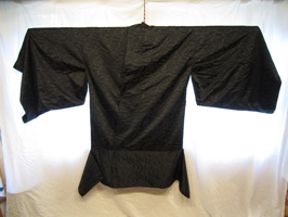 |
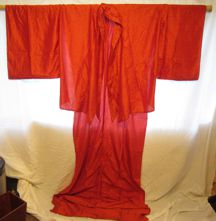 |
|
The long orange piece with the tail is a shitagasane the color must adhere to sumpturary regulations. |
Our friends the Baron and Baroness of our local barony, would be on the dais and she was speaking on Ishiyama's behalf, so we make them outfits. I make hers. I dyed the kosode, and the obi was fabric from the kosode that I made myself for the occasion. |
|
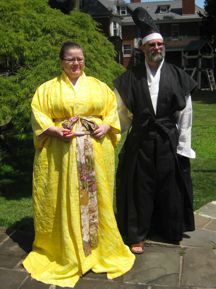 |
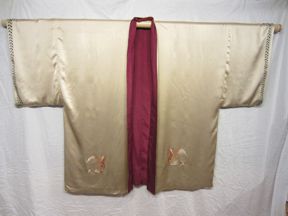 |
|
There is often a cloak for elevation. I made a lined dobuku, but the painting was done by Isabel. |
Notice the bunnies for honeybunny, and the laurel wreathes around the sleeve edge. |
|
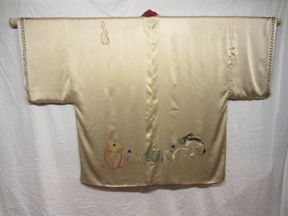 |
Gifts or Clothing made as an exchange
I made these outfits as gifts or as item to trade for other goods or services.
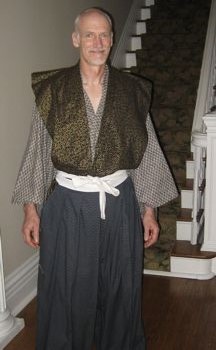 |
|
Outfit for Magnus's 20 anniversary of his knighting. I made the short kosode. |
I gifted Leah the uchikake so she had a nice outfit to complement her parents, their majesties. She needed an obi, a yellow kosode, and a white under kosode. |
|
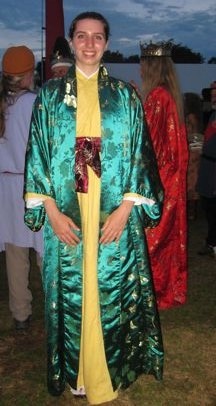 |
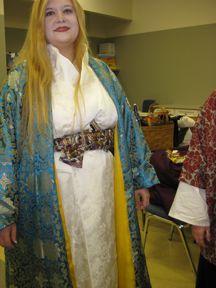 |
|
Honeybunny and I made Roxanne's outfit for her elevation to the Order of the Laurel. I dyed and sewed the lining for the uchikake, he sewed the shell. I make the white under kosode, and he made the dragonfly kosode under the white. The he made the obi. |
Ensemble on display at Ice Dragon |
|
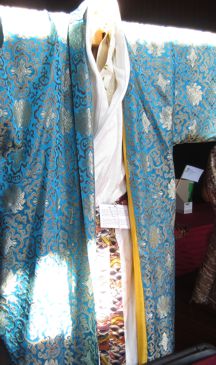 |
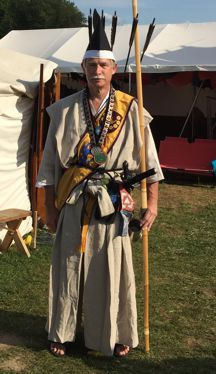 |
|
This is one of the nice outfits that I made for Kusunoki Yoshimoto, in exchange for him making me crossbow and bolts, then teaching me to shoot. I made the clothes, but the bling was all his award decorations. |
This second less formal outfit was payment for lessons and use of equipment as well as lessons on how to make my own bolts. |
|
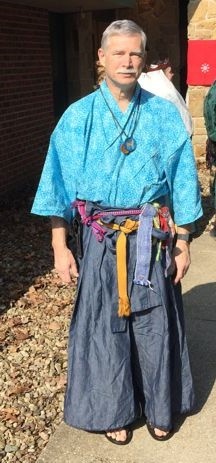 |
Dobuku and Shibori
I have made a number of Dobuku through the years as presents for others and one or two for myself. I also learned some shibori resist dyeing techniques. In the last Dobuku here, I put the two together. There are also a couple cool looking kosode that I make as well.
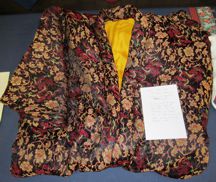 |
|
Padded and lined Dobuku. The lining as my first attempt to do that solid golden yellow dyeing. You can't see the little red spots of dye, but they are there. |
I partially made this dobuku, and then in a class, I taught the magic turn it inside out construction technique. (It's magic.) |
|
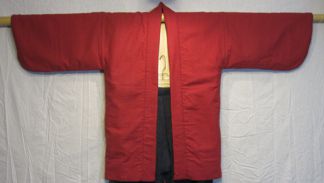 |
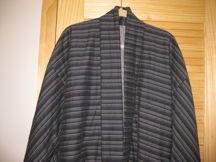 |
|
I made this as a present for honeybunny and then entered it in the Baronial Arts and Sciences competion at Twelfth Night. I one and then became the Baronial Champion for the next year. |
I even braided the cords for the ties. |
|
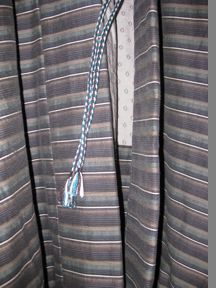 |
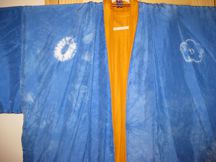 |
|
As Baronial Champion, I had to compete in the seven pearls competion against the other baronial champions in our kingdom. (Gulp). I constructed a dobuku that was more correct in proportions. |
It was also dyed with shibori resist patterns on the sleeves and at the shoulders and hem. The lining was also dyed that golden color that I tried earlier. This dobuku was a present for the clan dono. |
|
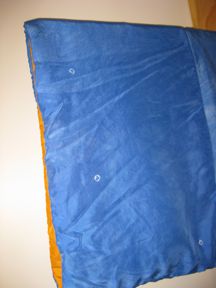 |
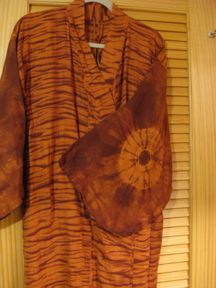 |
|
I did this burnt orange dyed kosode to cover up a stain on a light gray linen. The body, overlaps, and neckband used the arashi technique to create stripes. Then I created the spiderweb pattern on the sleeve. |
This kosode was first dyed yellow then blue. Mixing two colors with lots of resist makes it very interesting. |
|
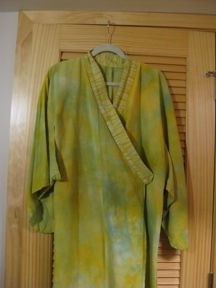 |
Early Items
I started by making european tunics using a pattern that I modified to change the neck or add grommet and ties to lace the front V. Then I made skirts without a pattern. The skirts were either simple casing skirt, or had a waist band, and a slit with grommets and ties to lace up at the waist. If I wanted something nicer or fitted, I would get a pattern for that. I made capes and a doublet using McCalls or Simplicity patters. Then when I started sewing Japanese, I started with Folkwear patterns. The problem was that the garments didn't look right, according to our friends. Some parts were too modern and others were not correctly proportioned for medieval Japanese clothing. Both my husband and I were sewing Japanese clothing, so we were both learning. We just started winging it or using directions that friends had written. As time has gone on, we found more information about the detailed construction, the proportion of the parts of the article and period fabric. We also learned about shibori dyeing techniques.
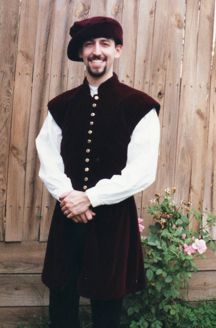 |
|
European Doublet sewn from pattern. |
Lined cape from modern pattern. |
|
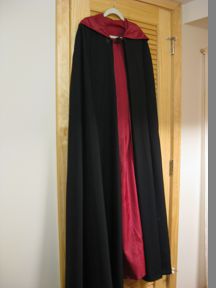 |
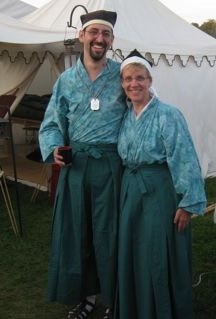 |
|
Japanese short kosode and hakama sewn from Folkwear pattern. |
Another short kosode and hakama, same pattern as before. |
|
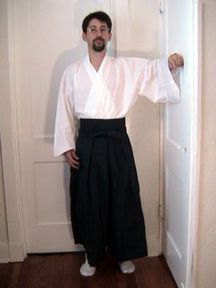 |
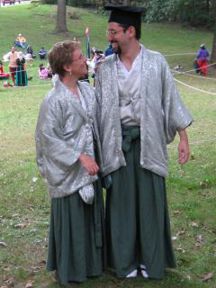 |
|
Nicer Japanese matching outfits. Honeybunny made the kosodes, under kosodes, and hakama. I made the lined padded jacket. |
Lined Padded Jacket from Folkwear pattern. |
|
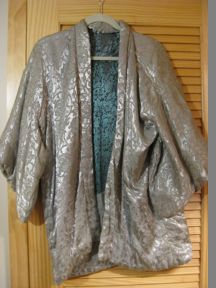 |
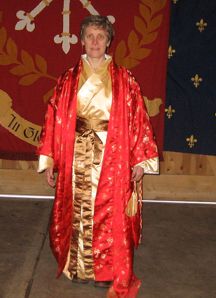 |
|
Long kosode with uchikake outer layer, no pattern, (just winging it.) |
In hot summer, uchikake is pulled off shoulder and worn tied with obi at waist. |
|
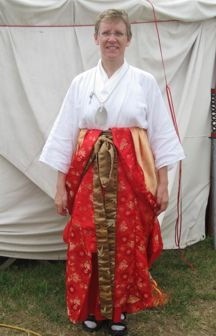 |
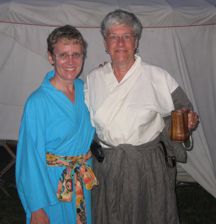 |
|
Long kosode for me, and short kosode with contrasting sleeve and hakama skirt for my Mom. I had to make garb for mom when she came to Pennsic for a few days. |
Another long kosode ensemble with uchikake. |
|
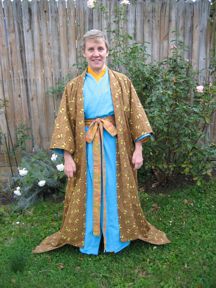 |
Online References by others in the SCA
-
Oribe Tsukime's research and publications for specific construction for Ladies 15th and 16th century kosode style garments.
-
Sengoku Daimyo website by Anthony J. Bryant and Joshua L. Badgley and specifically the Clothing and Accoessories sections.
-
The Kosode page on Wodefordhall website. Author Lisa Joseph aka Mistress Saiongi no Hana































